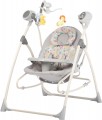Type
— Rocker. The distinctive feature of rockers as a type of swings is the adjustable backrest, which can be raised from lying to sitting position. The seat itself can be either adjustable or non-adjustable in tilt, but in any case the backrest and seat are adjusted separately. Rocker models can be used both for newborns and for older babies who are able to sit up on their own.
—
Bouncer. Chair bouncers differ first of all in that they do not have an adjustable backrest: only the tilt angle of the whole unit (backrest+seat) can be changed, and the unit itself is designed for lying down position of the child only. Thanks to the latter, all bouncers can be used from the first days of the baby's life; on the other hand, when the baby grows up and can sit up independently, the bouncer may not be so convenient.
—
Swing. Designs similar to classic children's swings: the seat unit is attached to a fixed stand and can swing back and forth thanks to movable fasteners (unlike other types that swing on curved skids, like classic rocking chairs). The advantage of the swing is the immobility of the base — they can be placed on any surface without fear of damaging it. On the other hand, swings take up significantly more space than other types. At the same time, there are models in which the seat unit can be removed and used separately as a rocking chair or bouncer (see above).
Weight limit
The maximum weight of a child that the swing can support without negative consequences in any position and in any mode of operation. A heavier child should not be placed: even if it does not break immediately, there is no guarantee that this will not happen at some point later, with unpleasant consequences for the child.
Backrest tilt adjustment
Possibility
of adjusting the backrest tilt of a swing. This adjustment is separate from the seat and provides the possibility to adjust the entire seat unit for both sitting and lying positions; in bouncers, the backrest tilt adjustment is performed simultaneously with the seat (see "Seat tilt adjustment").
Backrest tilt levels
The number of fixed positions in which the adjustable backrest of the swing can be installed (refer to "Backrest tilt adjustment"). Any adjustable backrest has at least two positions — lying and sitting, and the more levels of tilt — the more options you have for customizing the swing to maximize your baby's comfort.
Melodies / sounds
The music box has melodies and many of them have additional sounds (nature, rain, sea, etc.). The greater the range of songs stored in the device's memory, the greater the variety for the child and the greater the probability of finding the one with which the child will fall asleep, eat, play, etc.
More features
—
Timer. A timer that switches off the automatic rocking mechanism (refer to "Automatic rocking") after a certain time. Thus, knowing the approximate time your baby falls asleep, you can set the timer and not worry about the rocker continuing to rock unnecessarily while your baby sleeps.
—
Removable table. The presence of a removable table top in the design of the swing. Such a swing can play the role of a high chair; in addition, the table top can be useful for games.
—
Player connection. A function similar to a music box (see above) — with the difference that the sound source is not the memory of the box itself, but a player connected to the swing.
—
Vibration unit. The mechanism that provides the vibration of the seat unit — this plays the role of a massage for the child, and also creates a relaxing effect.
—
Arc with toys. A structure in the form of an arc or bracket above a swing, on which various toys are suspended. They can be used to play or to distract the baby (for example, to stop crying). The arcs are often made removable, and the brackets are also swivel.
— Lighting effects. Multi-coloured flashing lights that can cheer up or distract the baby (especially in combination with sound).
Remote control
Availability of a remote control in the delivery set of the swing. This remote control can be used to control various functions of the device (auto rocking settings, light and sound effects, etc.) from a distance, which will save you the need to go to the swing.
Power supply
—
Mains. Power supply from the ordinary 230 V mains supply. Such power supply is as reliable as possible: there are no batteries that can die at the most unfortunate moment. On the other hand, the use of additional functions of such a rocker is limited by the availability of the network (in nature, for example, they will be useless) and the length of the power cord.
—
Batteries. Powered by replaceable elements. This gives maximum freedom of movement: the rocker does not depend on the power supply and the length of the cord, its additional functions can be used anywhere and anytime. On the other hand, batteries have a limited charge and need to be replaced from time to time, and ideally you should have a constant supply of new ones, as some functions consume their charge very quickly.
—
Mains/batteries. Combined power supply, which provides the advantages of both previous types: as long as there is a mains power supply nearby, the rocker is connected to it, saving battery power, and when there is no mains power supply or the outlet is too far away, batteries are used.
Finishing material
The material with which the swing is finished externally. The absolute majority of modern models use fabric — this material is soft, pleasant to the touch, easy enough to clean and allows you to create different colors.

